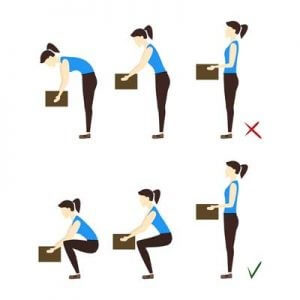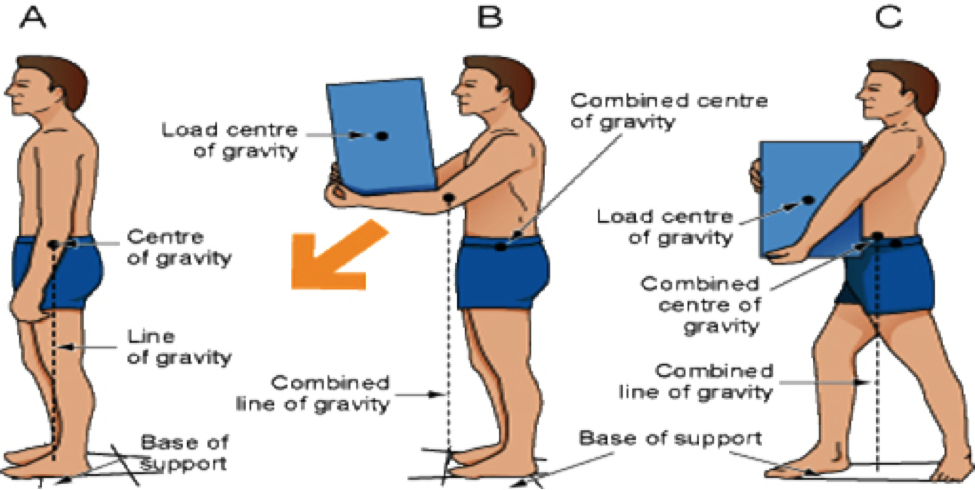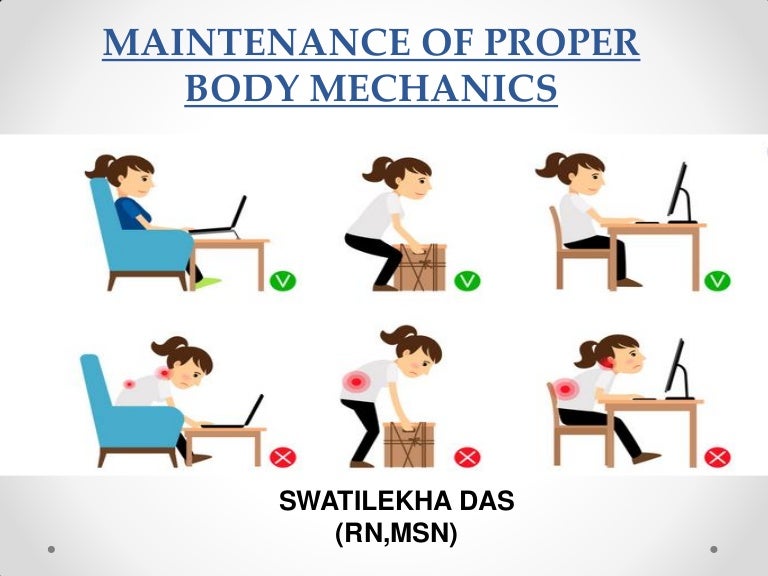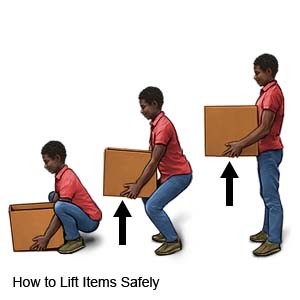1 Describe How to Maintain and Use Proper Body Mechanics
Body mechanics revolves around balance proper alignment and coordinated movement. Describe how to maintain and use proper body mechanics Equilibrium maintained as long as center of gravity aligns with base of support Facing direction of movement prevents abnormal twisting of the spine Balanced use of arms legs reduced risk of back injury.
Body Mechanics And Positioning Client Care Nursing Part 1
Use reg breathing patterns 11.
. Maintaining adequate muscle tone. Keep your back flat. Correct alignment minimizes undue stress and strain on the muscles joints ligaments and tendons whether one is seated standing or lying down.
Tuck in your buttocks. Reading When reading hold material in tilted position and maintain. Bow slightly using your hips and squat.
During his session on reducing injury and increasing output with proper body mechanics at the AMTA 2013 National Convention Edward Mohr shared some interesting results of a field. Pull your shoulders back and lift your chest. Pull your abdomen in and up.
Keep your chin in. Tighten your stomach and back muscles to maintain a correct support position. Place your buttocks at the back of the seat while maintaining a small space between the back of your knees and the seat of the chair.
Use your arms to support the person and let your legs do the lifting. 404 Techniques of Body Mechanics. When lifting something heavy or someone the proper body mechanics will help.
Shoulders should be relaxed and in a neutral position. Pushingpulling Never try to push or pull heavy objects ie furniture. Keep arms close to your body.
Keep the person or object as close to your body as possible. Keep your shoulders down chest out and back. Tighten abdominal gluteal and leg muscles in anticipation of the move.
Thus contributing to balance of the body. Keep stance feet shoulder-width apart. Get assistance if neccessary 9.
403 Principles of Good Body Mechanics. Keep hips level with knees. When the body is perfectly aligned body parts are in position to create optimal balance and function.
How efficiently you use your body. If you have doubts ASK FOR HELP. Good posture means that the body is in alignment with all the parts in balance.
To turn when lifting pivot your feet. This permits the musculoskeletal system bones and joints to work at maximal efficiency with minimal amount of strain on joints tendons ligaments and muscles. Larger stronger muscles 1st 2.
Bend at the knees and not the waist keeping your back and neck in a straight line with weight balanced on both feet. Bend at the knees and hips. Maintain curve in lower back and align ears over shoulders hips over ankles.
Pushing is better than pulling because you are using your whole body weight rather than. Proper Posture and Ergonomics. How do I practice proper body mechanics.
When moving a patient keep in mind these general rules of good body mechanics. Pivot by turning on one foot rather than twisting your body. The line should pass vertically through the base of support.
Dont twist at the waist. Maintain the Line of Gravity. Use legs with knees bent to shift weight side to side forward or.
The head and neck should be balanced and in-line with the torso. Use leg mobility to avoid trunk rotation 10. Stand close to the object being moved.
Keep your head up. Plan and confirm lift. The top of the monitor should be at or below eye level.
Good posture also aids other body systems to work efficiently. Keep your back straight. Facilitating body movement without muscle strain and excessive use of muscle energy.
Keep COG over BOS 4. Tips for Proper Body Mechanics Page 3 X22926bc 122019 AHC Osteoporosis. Keep your head upright and hold your shoulders up.
Keep your center of gravity low. PRINCIPLES OF GOOD BODY MECHANICS Maintain a Stable Center of Gravity. Use short lever arms 5.
Always avoid bending or twisting when you push or pull. Body Mechanics Field Study. PURPOSES OF MAINTAINING PROPER BODY MECHANICS Use of proper body mechanics in terms of posture and alignment helps in- reducing risk of injury to the musculo-skeletal system.
When you learn how to control and balance your body you can safely move another person. Keep your feet flat on the floor about 12 inches 30 cm apart. Do not twist your back as you lift.
Do not lock your knees. Lift with your legs NOT your back. Maintaining good posture while standing or sitting is an acquired skill that requires practice and training.
Bend knees to get closer 7. Utilizing proper body mechanics may help decrease back hip and neck pain and increase concentration and focus at work. Maintain adequate BOS 8.
Keep your feet shoulder width apart. Push pull or slide rather than lift whenever possible. Keep body in straight alignment.
Avoid crossing legs for long periods of time. Body mechanics is a combination of posture balance and motion all of which influence coordinated movement and stress placed on the body. Keep your back neck pelvis and feet aligned when you turn or move.
Tighten your stomach muscles. Lift your chin until it is level and relax your jaw and mouth. Keeping shoulder blades together head straight and preserving the three natural.
This helps you maintain your balance from side to side. Ensure proper body stance. Keep the object being lifted close to your body.
407 Steps Involved in Properly Moving an Object. 405 General Considerations for Performing Physical Tasks. Safe body mechanics require good posture.
Keep shoulders relaxed and avoid rounded back. Place the weight of the object being moved close to your centre of gravity for balance. 406 Reasons for the use of Proper Body Mechanics.
Know how much wt your moving 3. Bend knees and hips and keep your back straight throughout the movement. Place your feet flat on the floor with your knees bent at a 90 angle.
Stand up straight to protect the back and provide balance. Do not twist or bend at your waist. And learning how your work can be just as effective without being as hard on your body will help keep you in the profession you love.
Elbows should be close to the body and supported by some form of armrests. Posture-Sitting Sit upright head facing forward. Keep your abdominal muscles contracted and your lower back in its normal position.
Keep your back straight. Face your work. Keep the item lifted within the above constraits 6.
Hold objects close to your body when lifting and carrying. Body mechanics for the caregiver Section 1 Body mechanics involves standing and moving ones body correctly as well as making the best use of ones strength to prevent injury. Try using a roll to support lower back.
Move as close as possible to the patients bed. Maintain Proper Body Alignment.

Tips For Proper Body Mechanics With Lifting Goodlife Physical Therapy

Proper Body Mechanics For Nurses Nurseslabs

Maintenance Of Proper Body Mechanics

3 2 Body Mechanics Clinical Procedures For Safer Patient Care

Maintenance Of Proper Body Mechanics




No comments for "1 Describe How to Maintain and Use Proper Body Mechanics"
Post a Comment